Answer these simple questions and we will find you the BEST prices
Which type of solar quotes do you need?
It only takes 30 seconds
100% free with no obligation

Get Free quotes from insulation specialists near you

Save money by comparing quotes and choosing the most competitive offer

The service is 100% free and with no obligation
- GreenMatch
- Insulation
- Best Insulation Materials
Your UK Guide to Best Insulation Types

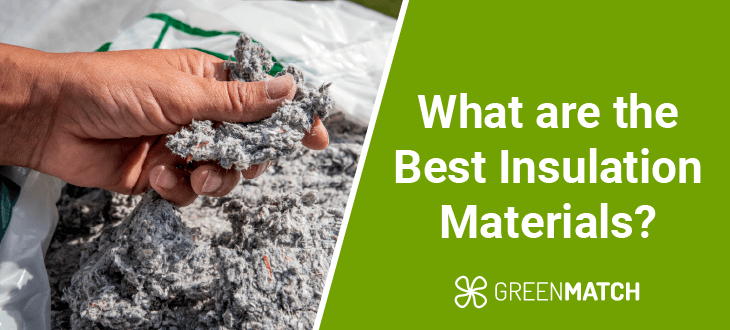
- Loft, wall and floor insulation can reduce up to a staggering 67% of home heat loss.
- Insulating your walls, floor, and loft can save you £630 - £730 annually on energy bills.
- The best insulation material for your home will hinge on factors such as your budget, existing insulation and personal preferences.
Unfortunately, the UK housing stock is known for its energy inefficiency. Research by the Resolution Foundation (RF) has shown that poorly insulated homes burn 58% more gas annually for heating than homes meeting insulation standards.
This leads to staggering energy bills, huge carbon emissions, and a damp discomforting living environment. That’s why insulating your home is an upgrade with endless benefits.
But which insulation materials are the best, and for what purposes? This complete guide by GreenMatch UK will give you everything you need to know about the best type of insulation for homes on the market, as well as how you can choose your best fit.
Ready to insulate your home? Let GreenMatch UK be your one-stop solution for all your needs. Instead of spending countless hours researching and vetting, just spend 30 seconds filling out our simple form and receive 3 free home-tailored quotes straight from our network of trusted installers. Click the button below to begin!
Fill in the form in just 1 minute
What is the best insulation type in the UK?

The best type of insulation hinges on several factors, such as your budget and property needs. A home insulation cost is no small financial feat, but there are options suited to all types of budgets.
Here are some top contenders that are worth considering:
- Mineral wool: Made from rock or glass, mineral wool is one of the most popular types of insulation due to its budget-friendliness, ease of installation and widespread availability. It has excellent thermal properties, fire resistance, and can be easily cut and shaped to fill awkward spaces. Better yet, it’s often made from recycled materials.
- Fibreglass: With a similar blanket-like texture to mineral wool, fibreglass provides most of the same qualities, but at an even cheaper price margin. It’s affordable, sustainable, easy to install, and very versatile, comfortably used in most insulation upgrades.
- Polystyrene (EPS): Making a name for itself in the insulation market, expanded (EPS) polystyrene is a popular choice for its exceptional thermal insulation, moisture resistance and anti-mould properties. EPS polystyrene beads are commonly used in cavity wall insulation but also come as rigid insulation boards for other purposes.
- Polyisocyanurate (PIR): This sturdy polymer is a highly effective thermal insulator that comes in the form of rigid insulation boards. With a fair cost, the robust material is very versatile in its application and is common for wall, floor and loft roof insulation jobs.
- Spray foam: Often found as polyurethane, this expanding foam may be more expensive, but has superior insulation capabilities and airtight sealing. As a downside, it could be a more sustainable option.
Apart from these different types of insulation, there are plenty of other options on the insulation market suited for all types of budgets, homes and purposes.
Best wall insulation types
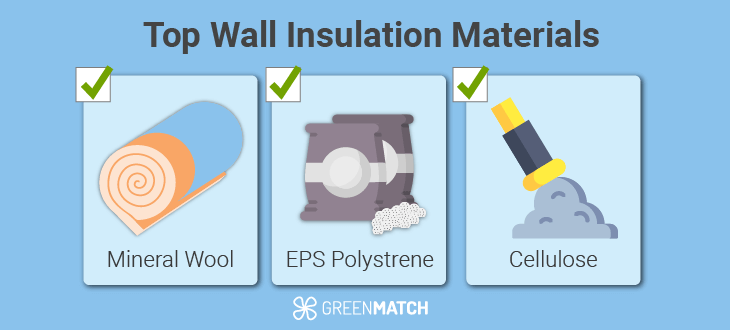
Insulating walls is one of the most effective measures any home can apply. It can cut domestic heat loss by up to 33%, saving a detached home up to a yearly £370 with cavity walls, and a staggering £500 with solid walls.
The type of insulation material you choose to insulate your walls with is also largely determined by whether your home has solid walls or cavity walls.
Solid walls are common with buildings built pre-1920s and comprise a single brick wall with no cavity space in between. These walls can only be insulated internally or externally.
Wall cavity insulation on the other hand is more common with post-1920 properties. These walls consist of an inner and outer wall with a cavity space in between. These walls are insulated by drilling access into the cavity space and injecting insulation materials.
EPS polystyrene
This handy, effective and versatile insulator is one of the most popular choices across the UK for walls, and for very good reason. It is relatively affordable, very durable, and even recyclable.
Costing around £18 to £22 per m2, EPS polystyrene exhibits high performance, as well as being mould and moisture-resistant. This insulation material can be found in the form of injectable beads for cavity walls, or rigid insulation boards for internal and external insulation.
Better yet, polystyrene can be reduced into granulate and made into new products in the future, making it relatively sustainable even if not a natural material.
Mineral wool
Costing just around £13 - £17.5 per m2, rock or glass mineral wool are some of the most affordable, available, and sustainable options on the insulation market these days.
With a decent heat retention capability, a very favourable price and ease of installation, it’s no wonder that it’s one of the most popular options for home insulation.
For internal and external wall insulation, blankets of mineral wool could be used as insulation, whereas for cavity wall insulation, blown mineral wool is injected into the cavity space.
Cellulose
Cellulose is by far one of the most sustainable options you could opt for when it comes to any home insulation upgrade. Costing a mere £10 - £12 per m2, it’s one of the cheapest options on the market.
Cellulose is also almost completely made from paper waste, biodegradable, and endlessly recyclable, making it a great choice for environmentally friendly home insulation.
Cellulose can best be used in internal wall insulation, by being filled behind stud walls, or for cavity wall insulation by injecting it into the cavity space. However, due to its higher susceptibility to moisture retention, it’s not often advised as a good cavity wall insulator.
Best loft insulation
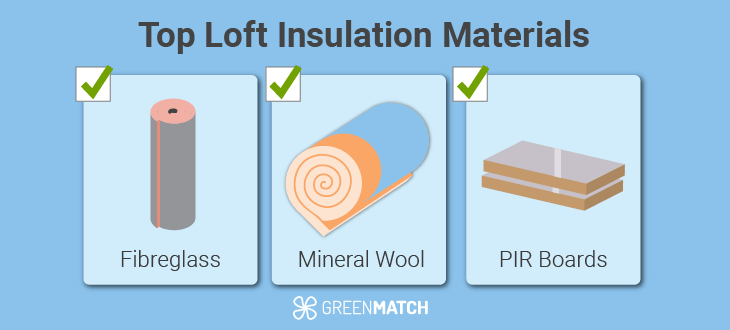
Loft insulation is another important home upgrade for those aiming to improve their thermal insulation. Uninsulated lofts can lead to over a quarter of home heat loss, making it a very worthy investment.
Several types of loft insulation stand out amongst customers when it comes to the best loft insulation.
Fibreglass
Fibreglass is a budget-friendly, sustainable, and easy-to-install insulation material that is very common in homes across the world. Costing an easy £10 per m2, this handy insulation type comes in sheets and can be very useful when insulating awkward nooks in your loft.
Fibreglass is also generally recyclable, comprising up to 60% recycled glass, making it a more environmentally friendly choice for loft insulation. However, it's good to keep in mind that fibreglass needs to be handled with protection, as it can be highly irritating to the skin, or if inhaled.
Fibreglass is very versatile and can be installed either between your loft floor joists or directly in the roof rafters for complete loft insulation.
Mineral wool
Mineral wool is one of the most popular loft insulation materials out there, given its affordability, effectiveness, and ease of installation. Its malleable blankets also make it very easy to insulate irregular shapes and hard-to-reach areas of your loft.
Polyisocyanurate (PIR) boards
Polyisocyanurate (PIR) boards are a very robust and effective insulator, especially suitable for flat surfaces. They are easy to install (even DIY!), very effective thermal insulators, and don’t break the bank.
Costing around £10 - £15 per m2, PIR boards have a higher r-value than most other types of insulation, are very sturdy, and even fire resistant, making them a great choice for insulating your loft space.
Best roof insulation
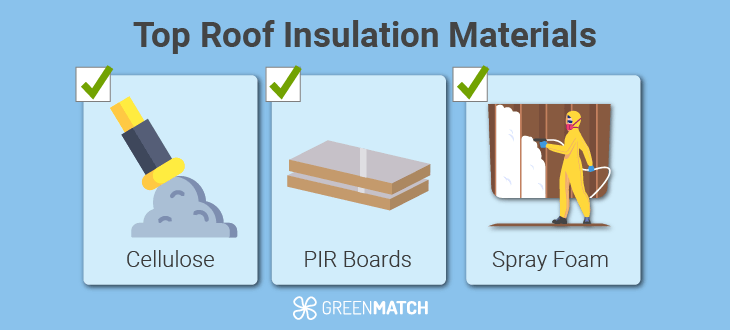
Some loft spaces aren’t fit to be used, however can still be insulated. Insulating your roof will bring your home great heat-saving benefits, energy bill savings, and carbon cuts, just as standard loft insulation.
There are some materials qualified to be the best loft insulation between rafters.
Cellulose
If your loft space is not in use, then cellulose emerges as one of the best roof insulation options. It’s cheap, effective, and fully sustainable. Loose-fill cellulose can be blown into your loft space with an applicator hose, keeping your home below nice and toasty.
Being made entirely from recycled paper products though, it’s important to make sure your roof space is properly sealed to avoid moisture buildup.
Spray foam
Polyurethane foam is one of the most thermally effective insulators on the market, creating an air-tight waterproof barrier on the surface it’s applied to. A bit more on the expensive side, spray foam usually costs around £21.5 per m2 or more.
It’s also important to keep in mind that despite its superior insulation capacity, spray foam is considered unsustainable and can sometimes risk off-gassing harmful gasses and VOCs during installation. It should always be handled with care by a professional installer.
Polyisocyanurate (PIR) boards
PIR boards work like a charm when insulating flat surfaces. For homes with flat roofs, they’re one of your best options, as they are waterproof, can withstand harsh weather, and are highly effective thermal insulators.
These boards can be added to your roof, on top of a vapour barrier, and covered with cladding and roofing material for a seamless finish.
Best floor insulation
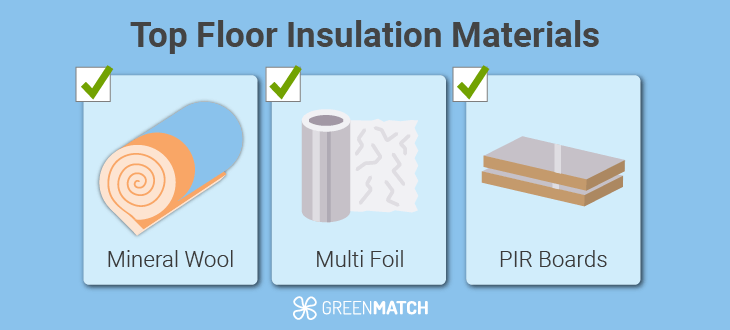
Uninsulated floors account for around 8% of the heat loss experienced in your home. By accounting for this with proper floor insulation, you can save
Generally, there are two types of floors; solid floors or underfloors. Solid concrete floors are more common with newly built homes, whereas older homes are likely to have suspended timber floors.
Suspended timber floors are when floorboards are laid on top of horizontal floor joists, which can be lifted and filled with insulation material.
There are some top contenders for the best underfloor insulation that are worth considering.
Mineral wool
The affordability, versatility, and ease of installation provided by mineral wool make it one of the most popular insulation type on the market, and it’s no different when it comes to floors.
Mineral wool is especially useful for insulating suspended timber floors, and can even be done DIY! Simply lift your floorboards, and lay mineral wool in between and over the floor joists before placing back the floorboards.
Multi-foil
Multi-foil insulation is probably the cheapest option on the market. Costing only £3 - £4 per m2, this handy type of insulation material is made from multiple aluminium layers bonded with foam insulation in between.
While multi-foil may not be as effective as some other insulation materials, its affordability makes it a very appealing option for underfloor insulation, especially considering the relatively smaller heat loss risk that comes with floors.
Polyisocyanurate (PIR) boards
PIR boards are very effective and useful, especially when insulating solid concrete floors that do not have an underfloor cavity. As previously mentioned, PIR boards are mostly renowned for their durability and effectiveness.
These boards can be laid directly on the concrete floor, and covered with plasterwork, screed, and floor covering for a smooth finish.
Best acoustic insulation
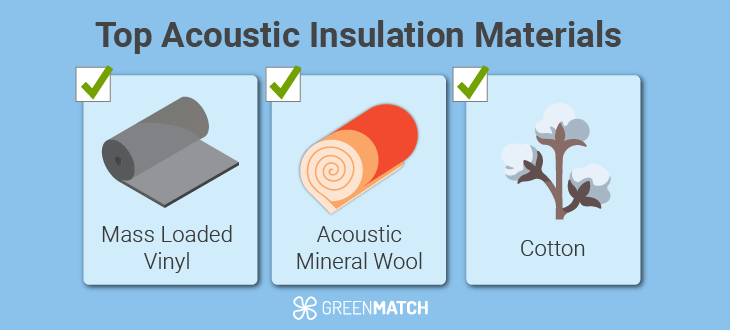
The main difference between acoustic and thermal insulation is that the former tends to be far denser in mass, allowing it to successfully drown out noise.
Contrary to popular belief, thermal insulation does not generally have acoustic insulation properties on account of its much lighter mass. Same way, acoustic insulation is not necessarily good at providing thermal insulation, but this depends more on the type.
Here are some of the best acoustic insulation types on the market.
Acoustic mineral wool
Higher-density mineral wool works as a great acoustic insulator. It’s affordable and still has some heat insulation capacity. While less effective in thermal insulation, this handy material works just the same way as mineral wool.
Acoustic mineral wool with a density of over 45kg/m3 and up to 100kg/m3 will work quite nicely as an acoustic insulator. For the best performance, installing mineral wool internal wall insulation, behind stud walls, will help reduce noise pollution in your home.
Cotton
While not popular as a thermal insulator, dense cotton is a highly effective acoustic dampener.
A 2017 study at the California State Science Fair tested several popular acoustic insulation materials and concluded that cotton was one of the best materials for noise cancellation.
Acoustic cotton insulation has an average density of around 55 kg/m³ and can cost around £10 - £14 per m2.
Mass loaded vinyl
Mass-loaded vinyl (MLV) is an innovative sound barrier that serves as one of the leading acoustic insulation solutions available on the market. It comes as highly dense sheets of vinyl that can effectively reflect sound due to its heavy impenetrable mass.
Unlike cotton, which absorbs sound, mass-loaded vinyl reflects sound, both preserving sound in the home and reflecting away sound from outside. On average, MLV costs around £10 - £20 per m2, but prices can vary depending on the material density.
How can you choose the best type of insulation?
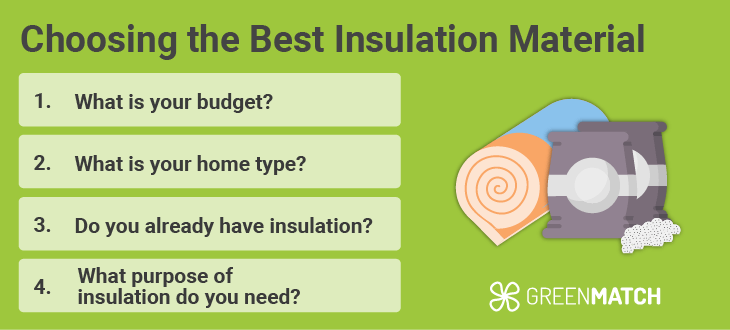
Wanting to insulate your home is a great start, but many can get overwhelmed when trying to make the best decision. The truth is, there is not one best insulation material out there, and the right choice for you hinges on several factors such as your budget, home type, and preferences.
To help guide your decision, here are some key avenues you should think about:
- Budget: Your choice will largely be dictated by how much money you are willing to spend. On the cheaper end, mineral wool or fibreglass emerge as some of the most affordable yet effective insulators, while PIR boards and spray foam cost more, but are superior in thermal efficiency.
- Home type: Home features will narrow down your insulation options. For example, if you have cavity walls, you will need cavity wall-suited insulation such as EPS polystyrene, or if you have a flat roof, you'll need PIR boards or other more rigid options.
- Existing insulation: If your home already has insulation in place that is healthy and functional, topping up existing insulation will always be the wiser choice, at least cost-wise. For this reason, check what types of insulation you may already have.
- Purpose: Thermal and acoustic insulation should not be confused with each other. Thermal insulation does not necessarily have soundproofing capabilities, and the same is often true the other way around. To make an informed decision, ask yourself what exactly it is that you want for your home.
Once you’ve narrowed down your ideal choice, seal the deal with a high-quality installation by working with a professional installer. An accredited trusted installer is the fine line between a peaceful insulated home and a financial disaster of repairs and maintenance.
Sadly, most prospective customers find themselves stuck in a tiresome loop of researching and vetting options, with no bargain in sight. Luckily, GreenMatch UK can do the dirty work for you.
Instead of wasting endless time on research, simply spend 30 seconds filling out our online form, and we’ll deliver you up to 3 free home-tailored quotes, directly from our network of pre-vetted UK installers. No cost, no obligations. Click the button below to begin!
Fill in the form in just 1 minute
FAQ
The most effective thermal insulator on the market is likely polyurethane spray foam, followed closely by rigid insulation boards such as polyisocyanurate (PIR) boards. These materials boast some of the highest r values of all insulation materials on the market.
Generally speaking, most industry-standard insulation materials will provide effective warmth to your home. You are likely to do just fine with options such as mineral wool, leading up to the most effective materials such as spray foam or PIR boards.
In the UK, the most popular wall insulation material depends on your wall type. For cavity walls, EPS polystyrene beads have climbed in popularity due to their effectiveness, as well as water and mould resistance. For internal wall insulation, mineral wool is a popular choice.
For a flat roof, you will require a robust option, such as PIR boards to withstand harsh weather conditions. For a loft space, mineral wool insulation is a safe bet that is affordable, effective, and easy to install.
All in all, the best cost versus effectiveness is found in mineral wool and fibreglass insulation. Both are relatively sustainable, affordable, and effective in thermal insulation. They are also quite versatile in their use and can be used in various home insulation projects.

Akif is a copywriter at GreenMatch since 2023. With a keen interest in community sustainability, green solutions and the role of digital media in identifying climate trends, he aims to hone in on his background in International Studies and Digital Media to provide a multidisciplinary approach to written content rooted in credible research and accuracy.
We strive to connect our customers with the right product and supplier. Would you like to be part of GreenMatch?

